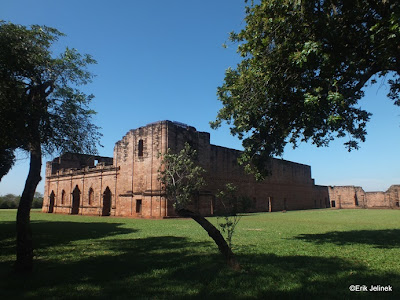You don't have to know me (or read my blog) for long to know that my views of organised religion are sceptical to say the least. I have seen far too much intolerance, violence, fear, hatred, bigotry and plain ignorance stemming from religious faith for me to want to have anything to do with it. Sure, it can be a force for good, though it seems to me that those are always individual cases that probably occur in spite of religion rather than because of it. Paraguay's history, however, provides one example of a religious organisation living up to its promises of fairness, justice, betterment. Sadly the temporal success of the Jesuits amongst the Guarani provoked the jealousies of the stronger colonial powers. Nevertheless their achievements still live on in today's Paraguay and form an integral part of the national narrative.
 |
| All that remains of the vast Baroque church at Jesus de Taverangue, a church that would have been considered grand even in a large, European city of the time, but built entirely by Guarani. |
The Jesuits, or Society of Jesus, came to the Americas late in the proselytising day, with the established Franciscan and Dominican orders having taken the choicest evangelising locations, so they had to settle for locations on the edge of colonial influence to spread their word. This proved to be a lucky move, as away from the meddling of central government the dedicated Jesuit priests set about founding reductions, settlements where indigenous people could come and live, be taught the Bible, European customs, culture and industry, and be protected from European slavers, particularly the Paulista bandeirantes. The missions proved to be very successful: the peaceful Guarani who lived in the area took to Christianity, and everything else the Jesuits had to teach, with gusto and enthusiasm. Architecture, reading, writing, the use of tools and instruments that had previously been unknown, all were happily taken up, whilst the Jesuits met the Guarani half way, learning their languages and culture, adapting Christianity to their reality, and not insisting on a complete adoption of European culture. So the reductions became peaceful towns, where the avid Guarani learnt how to farm, becoming self-sufficient, successful enterprises trading with their Spanish neighbours and sharing the proceeds amongst themselves. The Jesuits and their wards seemed to have managed to create an almost Utopian community, which even persuaded Enlightenment thinkers such as Rousseau and Voltaire, who were notoriously anti-church, to praise the Jesuits.
 |
| An example of the level of artistic and technical of the Guarani in the reductions: carving from the church pulpit at Trinidad. |
Of course the idea of inferior indigenous peoples having such autonomy and success irked the colonial authorities, who lived off the pillaging of indigenous communities and turning them into slaves (obviously the slavers considered themselves good and honest Christians and the hypocrisy of what they were doing was lost on them). Both the Portuguese and Spanish colonists put pressure on their respective crowns to expel the Jesuits, furious at being beaten by these upstart priests. And so the ultimate irony came to pass that the Spanish and Portuguese, who had carved up the New World between themselves with the benediction of Rome, under the pretext of bringing Catholicism to the heathen masses, were now kicking out a branch of the catholic church for actually practicing what it preached. The ruins of the dozen or so missions, with their grand churches and well-organised urban layout, are the only physical proof (and also only Paraguayan tourist attraction of any note) of what once was, a sad testament to a paradise lost and ultimate betrayal of religion that had finally lived up to its potential
But, despite the missions being disbanded (not only in Paraguay, but also further inland in what is now Bolivia amongst the Chiquitos and Moxos), thereby allowing the persecution of the indigenous population to carry on unabated, the 150 years of Jesuit influence among the Guarani proved to have a pivotal, and positive, long-lasting effect. By 1767 the Guarani were firmly established in colonial Paraguay and their descendents have come to be the majority ethnic group. Their language is also, along with Spanish, the official language of Paraguay, and can be heard on every street corner. They are the only indigenous group in South America east of the Andes to have culturally survived their encounter with colonialism (there are still a few indigenous tribes that still live traditionally, but they have remained separate and are not part of the mainstream), their gentle character and love of tereré having particularly permeated the national psyche.
 |
| Not much is left of the Jesuit missions, which were once thriving towns. Here are the remains of rows of indigenous houses. |
[For those who are interested in this little slice of oft-forgotten history Roland Joffé's critically acclaimed 1986 film The Mission, with Robert De Niro and Jeremy Irons, tells part of the story of the last days of the Guarani reductions.]
No comments:
Post a Comment